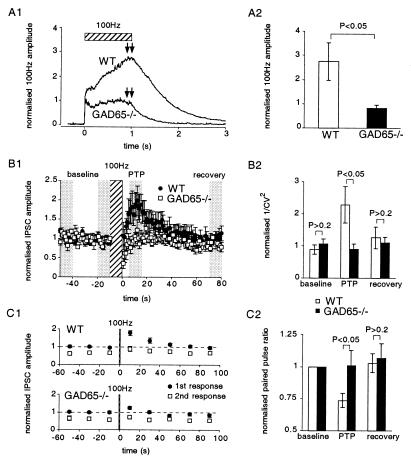Figure 4.
GAD65−/− mouse shows reduced release of GABA in response to high-frequency stimulation in the hippocampus. (A1) IPSCs are recorded in a hippocampal CA1 pyramidal cell in response to extracellular stimulation. Upon stimulation at 100 Hz for 1 sec, the IPSCs add onto each other because of their slow time course, and an envelope is recorded. The amplitude of the envelope is normalized to the amplitude of the responses to the previous 10 stimuli evoked at low frequency (0.1 Hz), allowing an average envelope to be calculated from the different experiments. In GAD65−/− mice less GABA appears to be released during the tetanic stimulation (WT, n = 8; GAD65−/−, n = 13). (A2) Average amplitude of the last 100 ms of the envelope in response to 100-Hz stimulation indicates that there is a significant reduction in GABA release (WT, n = 8; GAD65−/−, n = 13, P < 0.05). (B1) PTP also is reduced in GAD65−/− mice after 10 sec of 100-Hz stimulation (WT, n = 10; GAD65−/−, n = 7). (B2) Variance analysis was carried out on the four shaded regions of the data around the 100-Hz stimulation. Using one baseline period to normalize the 1/CV2 we have three regions of variance measurements. 1/CV2 increases during PTP for the WT mice, suggesting that the probability of release has increased, but no such increase is apparent in the GAD65−/− mice (P < 0.05). (C1 and C2) During PTP, the paired pulse ratio for WT mice decreased, suggesting that the release probability increased. No such change is observed in the GAD65−/− mice (WT, n = 8; GAD65−/−, n = 13: different set of cells to those used for the 1/CV2 analysis).

